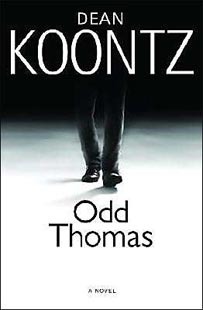It's Okay to Be Moody When You Write
Using Description to Characterize, Set the Mood, and Build Suspense
I’ve really enjoyed Dean Koontz’ writing through the years. And the endearing young man Odd  Thomas, the title character for a series of mysteries, is one of my favorite literary characters. Some claim Odd's one of the most beloved fictional characters of our time. I have to admit I have a bit of a crush on him myself. Here in this excerpt from chapter thirteen of Odd Thomas, Koontz follows the sound practice of showing us, not telling us the bad guy is truly evil. Here Odd Thomas investigates the room of Robert Robertson, whom Odd thinks of as Fungus Man.
Thomas, the title character for a series of mysteries, is one of my favorite literary characters. Some claim Odd's one of the most beloved fictional characters of our time. I have to admit I have a bit of a crush on him myself. Here in this excerpt from chapter thirteen of Odd Thomas, Koontz follows the sound practice of showing us, not telling us the bad guy is truly evil. Here Odd Thomas investigates the room of Robert Robertson, whom Odd thinks of as Fungus Man.
Side by side on the wall opposite the desk hung three black-and-white, poster-size photographs that appeared to have been printed on a draftsman’s digital plotter. They were head shots, portraits of men—one with feverish eyes and a gleeful smile, the other two glowering in the gloom. . .Charles Manson, the vicious manipulator whose fantasies of revolution and race war had exposed a cancer at the core. . .He had carved a swastika on his forehead. Whoever the other two might be, they didn’t have the look of either Vegas comics or famous philosophers. . . . [Koontz often inserts comic comparisons.]
Drawer after contained dossiers on serial killers and mass murderers.
The subjects ranged from Victorian England’s Jack the Ripper to Osama bin Laden, for whom Hell had prepared a special suite of fiery rooms. Ted Bundy, Jeffrey Dahmer. Charles Whiman, the sniper who killed sixteen in Austin, Texas, in 1966. John Wayne Gacy: He liked to dress up as a clown at children’s parties. . .
A particularly thick file had been assembled for Ed Gein, who had been the inspiration for both Norman Bates in Psycho and Hannibal Lecter in The Silence of the Lambs. . .
A portrait of Timothy McVeigh hung to the right of Manson. . .
To the left hung Mohammed Atta, who had flown an airliner into one of the World Trade Center towers, killing thousands. . . As with Manson and McVeigh, [Fungus Man] apparently admired Atta for the terrorist’s cruel vision, brutal actions, and accomplishments in the cause of evil. . .
This room was less of a study than it was a shrine. . . .
Most likely Fungus Man was unaware that his sanctum served not merely as a catalogued repository for his homicidal fantasies but also as a terminal admitting bodachs [demonic spirit creatures] to a holiday of blood. Without my sixth sense, perhaps he could sit here, happily working on one of his grisly files, and not be conscious of the ominous transformation of the room or of the arriving hordes of demonic entities.
From nearby came a tick-tick-tick, a bone-on-bone rattle that brought to mind Halloween images of ambulatory skeletons. . . .
Perhaps Robertson [Fungus Man] required few luxuries because he found all the pleasure he needed in ceaseless bloody fantasies that gouted through his imagination. . . .
A sudden frenzied flapping-rattling almost brought me up from the chair again, but then a sharp and repeated skreek [a cool onomatopoeic invention of Koontz’] identified the source as crows pecking out their turf on the roof. . .
Even though Odd Thomas (and the reader) haven't even met the guy yet, this description of Robertson's room leaves no doubt in Odd Thomas' mind (and that of the reader) that he is truly evil. Koontz's description is used to build Robertson's character, to create a creepy mood, but also to ratchet up the novel's suspense. Just seeing where this guy lives causes the reader's dread and fear of the hero’s inevitable meeting with him to sky-rocket.
Write Brain Activity
1. What words in the passage contribute to the ominous mood of the piece?
2. Besides description, by what other methods do authors develop characters?
3. Do you think the mention of clowns helps or hinders the mood Koontz is trying to create?



